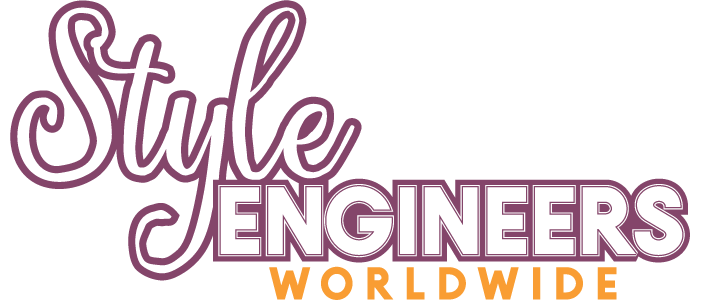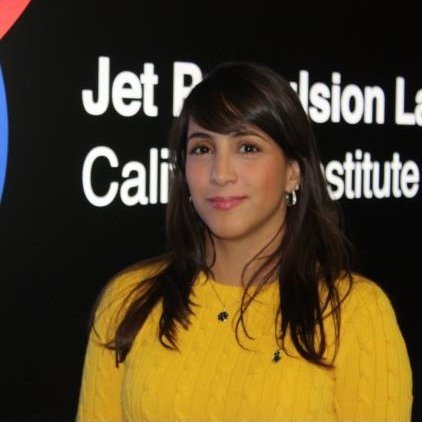STEM Spotlight: Luz María Martínez Sierra
Credit: NASA
Put your space shields on, because we've got Dr. Luz María Martínez Sierra on the blog today, and she radiates radical awesomeness. Luz María is a nuclear engineer and space environments technologist at NASA's Jet Propulsion Laboratory. She researches ways to protect rockets 'n robots 'n more from the perils of space including the sun's harmful radiation and the treacherous atmospheres of other planets. After all, space is very cool, but it's also very dangerous, so we are lucky to have engineers like Luz María working to keep otherworldly exploration safe for robotic —and eventually human— pioneers. (Read on to find out what that looks like!)
Not only is Luz María's career quite amazing, but so is her life story. She is originally from Medellín, Colombia, and her family moved to the United States when she was a teenager. In a few short years, Luz María earned her master's in engineering physics and her PhD in nuclear engineering all while learning a new language. Not only that, but she's an extremely talented artist who creates out of this world #SciArt. Luz María's illustrations have a magical quality, the kind that comes from deep creativity fused with scientific curiosity.
We were thrilled to ask Luz María about her advice for young engineers, her work at JPL, her fave nuclear engineering fact, and more. Meet Dr. Luz María Martínez Sierra, space environments technologist.
At what age did you know you wanted to become an engineer?
I think pretty early. Honestly, it was all the way back to elementary school when I was a young kid studying the planets. But at the beginning, even though I knew that was my dream, the idea of studying engineering was still so uncertain to me. I wasn’t sure what was available to me. I had studied in another country, and my parents came to the US when I was eighteen, so there weren’t a lot of financial resources, and the language was also a barrier.
I got very lucky because I came across a university called Embry-Riddle Aeronautical University in Florida. And I immediately started talking with people at the school, asking simple questions like, “Where is the office for international students?”, “Can I talk to the physics department?”, and so on. And the more questions I asked, the more people helped me.
For example, I found someone who spoke Spanish, and then he helped me with filling out the application and understanding all the unfamiliar terminology that was part of the process. Over the course of that experience of talking with lots of people, I was accepted into the school and became firmly rooted in my engineering career.
If my journey to engineering has taught me anything, it’s never assume the answer will be no. Never believe ahead of time that you will be rejected, or even if you are, that the rejection is permanent. There are always opportunities available, there are always people willing to help, and there always new ways to try things.
Art by Dr. Luz María Martínez Sierra, featuring Mars explorers
What are the top three things you spend most of your time doing at work every day?
Most of what I do is computer simulations. That means I use software to mimic what is happening on other planets or in space to decide on the best way to do a mission.
In particular, I focus on Mars. So, let’s say, we know the soil content or the atmosphere on the planet. My job is to run those numbers and test what happens if we introduce something new to that environment. For instance, if we want to build a habitat for future astronauts on Mars, what happens if we build it out of aluminum? Will it blow away in the wind? Or what happens if we build it out of lead? Will it be too heavy to safely enter the atmosphere? By using computer simulations, we can predict what will happen if we try different things, which is much safer and less expensive than bringing these different materials into space and trying there.
When I’m not running simulations, I also create presentations showing my findings, or am writing reports so other people can understand what exactly we learn when perform our computer tests.
What advice do you have for middle and high school girls who want to pursue an engineering career?
I think being an engineer is about being curious. It doesn’t necessarily mean just focusing on being the top student and getting all your work done. It means really taking in interest in how the world around you works.
To help with that, my recommendation is to actually get out of the textbook a little bit. Get your hands on experiments or on a computer and learn how to be comfortable with it. You don't need to buy one of those fancy expensive robotic kits, you can try just looking at simple little things around your house.
Ask your parents to help you take something apart, like lawn mower or a remote control and look inside and understand how it works. Machines seem scary at first, but once you become familiar with them, they actually become really interesting!
What types of entertainment do you enjoy? Any good recent recommendations?
I love reading! I’m actually part of a book club at NASA. We vote on a new genre each month. I particularly like science fiction, fantasy, and science nonfiction. I also like biographies of famous scientists or the history of science, such as who first discovered the magnetic field and how they developed the first compass.
A TV series that I would recommend everybody to watch or read is the Cosmos series from Carl Sagan. Of course, that was made like 20-30 years ago, so anyone watching that now has to keep in mind that we’ve discovered a lot since then, but the basic ideas and how they’re communicated is just amazing.
Who or what inspires you in life?
There are a ton of professors I have to thank for getting me to where I am, as well as my family, which has always been amazingly supportive and helpful.
But another major source of inspiration is the young women who come to blogs like Style Engineers Worldwide and who are so smart and motivated. Knowing they are here just inspires me to keep doing what I'm doing because I’m part of a process setting the stage for these girls to go on to do great things.
Every time I do an outreach event at a school where young women and girls are asking me questions, I come back to work and I'm more motivated to continue doing what I'm doing. For us who are already professionals in the field, it reminds us of that passion and curiosity and why we wanted to get into this work in the first place.
We love your #SciArt and your @astronucleart Instagram account is so awesome! Can you describe how your work as a nuclear engineer influences your creativity?
That’s a good question. The more I think about it, the less I understand why there’s this perception that you have to choose between a STEM career and being creative. To me, they’re usually complements.
In my case, I liked this drawing and doodling as a hobby. One time, I was in a meeting and we were talking about Mars. I was trying to draw it, thinking: what colors should I make it? How can I show the craters? How can I show the atmosphere without drawing clouds, since Mars doesn’t have big clouds? That’s when I realized that all of the scientific knowledge I’ve been gaining was actually helping to influence my art.
Now, when I'm doing a presentation or a report, I like to include some of my drawings or make my graphics colorful. Even my teammates have started asking if I can show off some of my drawings as part of their presentations. In the process, I’ve been able to mix art and science, allowing both sides of my brain to engage. It’s been very rewarding.
When I first decided to start sharing my drawing on social media, it was scary. But I have a lot of support from friends and family and seeing how much they enjoyed it made me feel encouraged. I’d get text messages saying, “This reminds me of when Perseverance landed!” or “This made me curious to start learning more about this planet.”
At the beginning I only had six followers, and they were all my cousins and friends. But after a while, I started to gain more and more. I don't have any have any problem speaking out and trying to talk to people about space, so I was really happy that sharing my art also allowed me to share that passion.
Do you have a particular nuclear space engineering fun fact you like to dazzle people with?
One thing that I think is pretty cool is that, when you go to the dentist, they sometimes have to make an X-ray of your mouth. When they do that, they put that lead apron on you to protect your body from the harmful X-ray radiation that comes from the machine.
We have to do exactly the same with spacecraft. The Earth has a giant magnetic field that protects us from the X-ray radiation in space, but once you’re in space, you’re exposed to rays that could damage your equipment or your health. So we come up with different types of “aprons” to put on spaceships. Usually, they’re not lead because that’s too heavy, but they might be aluminum foil, or an extra layer of a type of plastic that absorbs the radiation. But either way, it’s interesting that something so important to space travel is something you’re probably used to seeing at your dentist’s office.
If you were a superhero, what would be your go to wearable tech device?
I think it would be goggles that allow me to see Carbon 14. Carbon 14 is a material that we use to look at rocks or fossils and it can tell you how old they are. Depending on the amount of Carbon 14 a rock may have, for example, it will emit certain amounts of gamma rays or X-rays. And if you’re able to see how many there are, you can determine its age. If I had these googles, I could go anywhere on Earth and know immediately whether a rock originally came from the sea floor or from inside a volcano or from mars or even form an asteroid outside our solar system. And that would be so cool because it would be like solving this really amazing puzzle. These types of machines actually do exist, but they’re big and expensive. I want them as googles so I can have a cool superpower!
To learn more about Dr. Luz María Martínez Sierra, follow her on Twitter and check out her art on Instagram!


